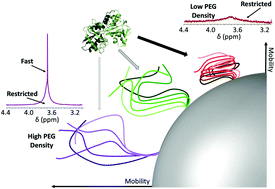Impact of dynamic sub-populations within grafted chains on the protein binding and colloidal stability of PEGylated nanoparticles†
Abstract
Polyethylene glycol grafting has played a central role in preparing the surfaces of nano-probes for biological interaction, to extend blood circulation times and to modulate protein recognition and cellular uptake. However, the role of PEG graft dynamics and conformation in determining surface recognition processes is poorly understood primarily due to the absence of a microscopic picture of the surface presentation of the polymer. Here a detailed NMR analysis reveals three types of dynamic ethylene glycol units on PEG-grafted SiO2 nanoparticles (NPs) of the type commonly evaluated as long-circulating theranostic nano-probes; a narrow fraction with fast dynamics associated with the chain ends; a broadened fraction spectrally overlapped with the former arising from those parts of the chain experiencing some dynamic restriction; and a fraction too broad to be observed in the spectrum arising from units closer to the surface/graft which undergo slow motion on the NMR timescale. We demonstrate that ethylene glycol units transition between fractions as a function of temperature, core size, PEG chain length and surface coverage and demonstrate how this distribution affects colloidal stability and protein uptake. The implications of the findings for biological application of grafted nanoparticles are discussed in the context of accepted models for surface ligand conformation.



 Please wait while we load your content...
Please wait while we load your content...